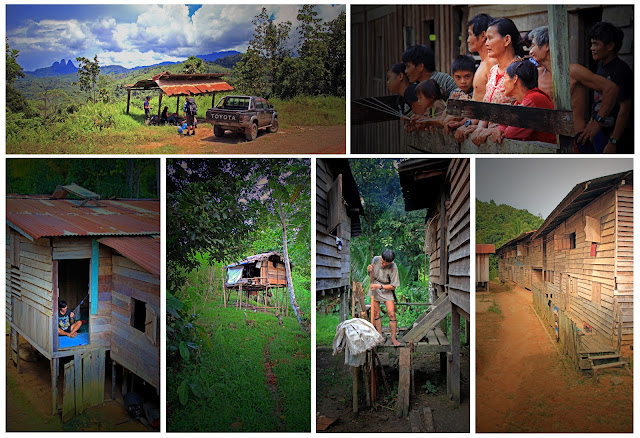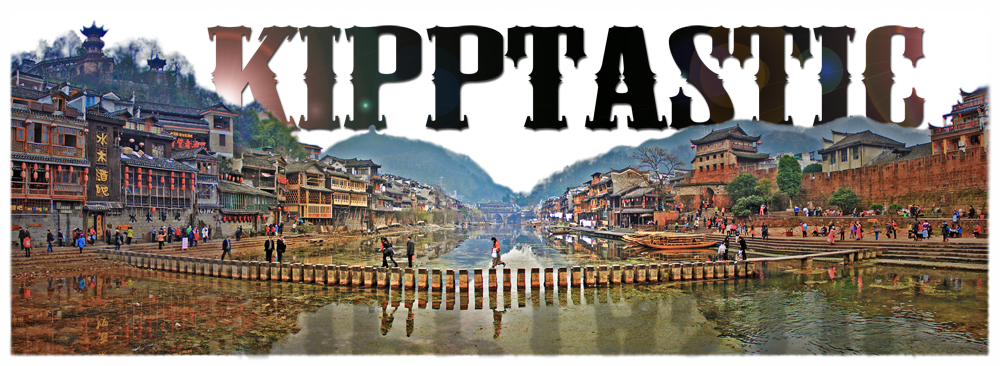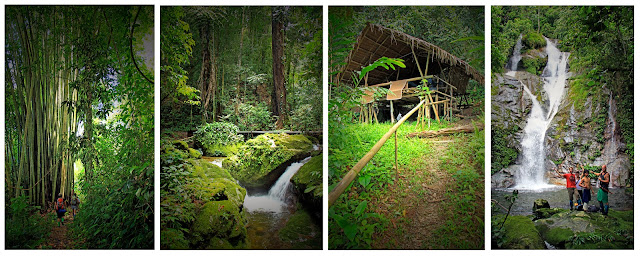My journey from China to Borneo, and the quest to find my friend Charlie, came to an end when we reunited on the banks of the Bejelai River in the tiny village of Long Ajeng. But reaching Charlie wasn’t easy. In fact, I’ve never been to such a remote place in my entire life. Charlie was out in the jungle when I arrived in Kota Kinabalu, and instead of waiting for him to return, I pieced together the few clues that he left me, and made my way deep into the rainforest to find him.
Charlie volunteers with a small organization that coordinates community projects with the Penan. There are only a few thousand of these historically nomadic hunter-gatherers left in the world, and only a couple hundred that still live in the forest and maintain their traditional lifestyle. Most Penan have left the jungles to find work in the cities, leaving behind a dwindling population that not only struggles for cultural survival, but is also forced to confront the irrepressible logging industry which continues to rapidly shrink their natural habitat. The projects Charlie collaborates on are part of a five village cooperative run by the Penan that directly contributes to their community. Getting to a Penan village is no easy task, but for those who are interested, Charlie can act as a liaison for the cultural exchange, organizing home-stays, jungle treks, and re-forestation projects. Because of its inaccessibility, this kind of ‘tourism’ isn’t very popular; the last foreigner to visit the village where we stayed was Charlie, and that was almost six months ago.
My quest to find Charlie started with a twelve hour bus ride along the northern coast of Borneo to the town of Miri. The next morning I met up with Charlie’s friends Sarah and Manitre, and a young British couple, Simon and Emma, and the five of us boarded an airplane for the forty-five minute flight to Long Akah. We were all searching for Charlie, but no one knew exactly where to find him. The twin-prop airplane was tiny, and the loud and bumpy flight through the clouds had me humming the Indiana Jones theme song and feeling excited for the upcoming adventure. The airport in Long Akah was basic to say the least - little more than a landing strip in the jungle - and since there was no electricity or computers, we casually signed up in a notebook for the next flight back to Miri in five days time. Charlie’s friend Ken picked us up in his truck for the next portion of our trip, a bumpy meander through the forest on a dirt logging road. Traffic was light except for the procession of ominous logging trucks that rumbled along, kicking up dust as they pulled the forest apart little by little. After an hour and a half Ken dropped us off by a small make-shift shelter and pointed us down an overgrown trail into the jungle. It was the last time we’d use a road for five days. "There’s a village thirty minutes that way." "Is that where Charlie is?" "I don’t know..."
Sarah and Manitre were along on the adventure to initiate a collaborative project with the Penan. Sarah’s architecture firm is planning a summer workshop where students will spend a month working with the Penan to conceptualize and build a pondok in the forest. A pondok is an elevated jungle shelter, usually small and semi-permanent, used as a resting place while out on hunting excursions. The plan for the collaboration is to create a larger permanent structure that the Penan can use while hunting, but that can also double as a base-camp for tourist jungle treks. Manitre is Penan, but lives in Kota Kinabalu, and came along to translate and help Sarah facilitate discussions about the endeavor.
After a sweaty forty-five minute hike, the trail bumped into a river, across which sat the village of Long Laman. Luckily there were a few villagers hanging out on the opposite bank, and before long they came floating over in a boat to retrieve us. There’s no cell phone service in the jungle, and communication is sparse, but when there’s a muscular six-foot-two bald dude with tattoos in the vicinity, people tend to have an idea of where he is. We caught word that Charlie was an hour and a half away in Long Ajeng, so after a round of tea with the villagers, we boarded some wooden boats for the final leg of our journey. After a brief float down-stream, we hit a fork in the river and turned into the current, finishing our boat trip with sporadic wading and an occasional walk through the shallows. It was mid-afternoon when we finally reached the village, and just as we’d heard, Charlie was there with his girlfriend Jess. With a spattering of stilted huts and a host of smiling villagers, Long Ajeng welcomed us with charm and repose after our lengthy trip.
 |
| Top-left: Getting ready to hike in and find Charlie. A few days later we'd be at the base of the three mountains in the background. Top-right: The villagers of Long Ajeng seeing us off before our jungle trek. Bottom-left: Yesiah weaving a fishing a net. Middle-left: The modest stilted home of Yawa - the village head of Long Ajeng. Middle-right: A village elder working on a new blowgun. Bottom-right: The longhouse in Long Ajeng. |
Around fifty years ago, due to government control and the introduction of Christian missionaries, the nomadic Penan were coaxed into a more settled lifestyle. In the tradition of their more rooted indigenous neighbors, the Penan built their riverside villages around a communal longhouse - a primitive apartment building with separate units that branch off of a shared space. Since most of the villagers still spend months on end out in the jungle, the longhouse in Long Ajeng was largely vacant, leaving plenty of space for us to stay. Upon arrival I was shown to a dark second-floor room and given a simple bamboo mat to sleep on. After putting down our bags we went back to the river for a swim and splashed around in the water for the remainder of the day, outlasting an afternoon rainstorm that blew over the forest. The evening commenced with a large meal that rolled into a multi-village gathering to discuss Sarah’s proposal. The generator was turned on in an attempt to provide the get-together with some light, only to putter out five minutes later and leave everyone to their usual headlamps and flashlights. Three different village heads were present, along with a crowd of curious villagers, and all those attending seemed enthusiastic about the collaboration. The next day we left the village to explore the jungle and to scout out an ideal location for the project.
Jawa, the village head of Long Ajeng, led us into the jungle the next morning along with two other young men, Roger and Tisun. A half hour into our trek we were joined by two more neighboring village leaders, bringing our caravan to a total of twelve. All three village leaders trekked with their knife-tipped blowguns in hand and a quiver of lethal darts next to the machete on their hips. The blowgun is the preferred weapon for hunting, and the Penan use it to shoot and kill everything from birds to monkeys to wild boars. The tree sap they use to poison the darts is highly lethal, and is easily strong enough to kill a human. Jawa wore the traditional bowl-cut style hairdo and his earlobes were droopy from the customary weighted jewelry. He glided along with a calmness and confidence that could only come with the deepest knowledge of the rainforest. The barrage of greenery was like a familiar story; the foliage like the pages of a book he’d read a million times. He was in his element, and I was totally out of mine.
Five hours later we reached the prospective project site, and after a short rest we went about setting up camp. On a flat spot at the bottom of a steep hill, right next to a beautiful clear jungle stream, sat an old pondok, and while our Penan guides worked on re-constructing the tattered lean-to, the rest of us searched for an ideal spot to hang our camping hammocks, eventually settling on a cluster of a trees across the creek. Not long after we set up camp, a downpour came along and sent the twelve of us huddling under the tarps of the cleverly constructed new pondok. At one point we heard a soft rumble and looked up to see a torrent of brown water come crashing down the gentle stream. Within seconds the once ankle-deep creek had transformed into a dirty waist-high river! The rain lasted for a couple of hours, but even after it stopped, the forest continued to drip and glisten in the late day sun.
 |
| Left: The make-shift pondok at the jungle campsite. Middle-left: Jawa's woven backpack, his blowgun, and a quiver of poisonous darts. Middle-right: Charlie wades across the flooded stream. Our camping hammocks are strung across the trees in the background. Right: Looking up at the mountain before climbing up to the lookout. |
For dinner we had a light fish stew with rice, and a few hours after dark Roger and Tisun invited us on their hunt for the next day's breakfast. Roger had been quiet on the hike in, and had lagged behind and had gone mostly unnoticed. But that night he came out of his shell. With our jungle boots and headlamps we waded into the water and followed our guides upstream, Tisun carrying a fishing net and Roger wielding a blowgun with a quiver of darts. Roger’s stealthy nocturnal agility was awe-inspiring. As I tried my hardest to keep up, clumsily splashing through the current and slipping about on the aqua-terrain, Roger cruised along barefoot, side-stepping through the darkness in a crouched position, cutting back and forth from bank to bank with blowgun in hand. Using the flat side of the double-edged knife on his blowgun, he would sneak up on heedless frogs and bring their life to an end with an explosive whack, then scramble up a steep riverbank and blow a dart into a sleeping bird on a tree branch, sending a poof of feathers into the beam of his headlamp, and a lanced bird into the water below. It was ridiculous how easy he made it look, and how absolutely clumsy the rest of us were as we tried to keep up with him. Tisun was right by his side, unfurling the weighted fishing net into dark pools of water and pulling out a tangle of small fish and river eels. The two of them terrorized little night creatures all up and down the river, at least the ones that weren’t scared off by the awkward and clamorous gang that followed. And of course we had plenty of food for breakfast the next morning.
Sarah’s reconnaissance of the area was favorable and the spot seemed ideal for the upcoming project, so the next day after a fried fish and frog breakfast we broke down the camp and wandered back into the jungle. The plan was to head to the village of Long Marung, but not before exploring some caves and hiking to a lookout. After an hour or so we dropped our bags, covered them with a tarp on the forest floor, and took off to do some spelunking. Roger and Tisun took the lead from there and right away had us bushwhacking through thick undergrowth. I stumbled along behind them, sweating bullets and trying not lose my footing as we ascended muddy slopes and scaled rotting logs. We entered a bat-filled cave at the bottom of a steep ravine, and I was immediately overwhelmed by a sense of claustrophobia. The cave was tiny and damp, and within two minutes I’d been slapped in the face by an unruly bat. We squeezed our way through small tunnels, grinding against slimy rocks, and trying at all costs to avoid the gargantuan poisonous millipedes that clung to the walls. Fortunately, it was a rather brief and anti-climactic exploration, and after twenty minutes I resurfaced covered in guano and feeling a little freaked out. After scarfing down some leftover rice for lunch, we took off for the lookout.
A few days earlier, when Charlie’s friend Ken had dropped us off on the logging road at the start of our trek, he pointed out three side-by-side karstic mountains rising out of the faraway jungle. The lookout was perched near the base of one of these triplets, and reaching it required climbing up vines and rocks to a shelf about seventy-five feet above the jungle floor. Tisun boldly hung out over the ledge and cleared some foliage with his machete, revealing one of the neighboring peaks and a partial view of the forest below, along with a quickly approaching raincloud. It wasn’t long after we left the lookout that we got caught in a torrential downpour. We were drenched by the time we got back to our tarp-covered bags, and while most of them were dry, they were all covered in an army of fire ants. I threw my backpack on under my poncho, only to realize that I’d trapped a few inside. Ouch.
After three stormy hours, it was decided that visiting Long Marung would be too difficult. The probable swelling of a large river that we’d have to cross would be too risky. Instead we decided to head back to Long Ajeng; it was a longer trek, but a safer bet. The rain was unrelenting, and the harder it fell, the weaker I got. I’d started that morning with a small blister on the side of my right ankle from my new jungle boots, and while it was nothing but a light abrasion, it was enough for me to fall victim to the bacterial breeding ground of the rainforest and the onset of a nasty infection. By the time we stumbled back into Long Ajeng it was almost nightfall and I was running a fever. After a quick rinse in the river, I climbed up to my second-floor room in the longhouse and collapsed into a febrile thirteen hour sleep. The jungle had taken it’s toll.
I felt better the next morning, and although my fever had subsided, the infection had started to spread into the rest of my foot. Relaxing in the village wasn’t going to remedy the situation, but that was all I could do until our journey out the next day. And so after an easy day of swimming, eating, and hanging out with the villagers of Long Ajeng, we retraced our steps out of the jungle and made our way back to Kota Kinabalu. My foot was starting to swell, but it was nothing that a heavy course of antibiotics couldn’t fix. And for me, it was well worth the adventure! I’d only been in Borneo for seven days, and it had already been one of the most memorable weeks of my life. I’ve got a few months left in this part of the world, and a return visit with the Penan is already in the works...







